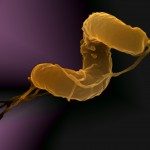Lien vers Pubmed [PMID] – 17002496
PLoS Pathog 2006 Sep; 2(9): e97
The human gastric pathogen Helicobacter pylori is responsible for peptic ulcers and neoplasia. Both in vitro and in the human stomach it can be found in two forms, the bacillary and coccoid forms. The molecular mechanisms of the morphological transition between these two forms and the role of coccoids remain largely unknown. The peptidoglycan (PG) layer is a major determinant of bacterial cell shape, and therefore we studied H. pylori PG structure during the morphological transition. The transition correlated with an accumulation of the N-acetyl-D-glucosaminyl-beta(1,4)-N-acetylmuramyl-L-Ala-D-Glu (GM-dipeptide) motif. We investigated the molecular mechanisms responsible for the GM-dipeptide motif accumulation, and studied the role of various putative PG hydrolases in this process. Interestingly, a mutant strain with a mutation in the amiA gene, encoding a putative PG hydrolase, was impaired in accumulating the GM-dipeptide motif and transforming into coccoids. We investigated the role of the morphological transition and the PG modification in the biology of H. pylori. PG modification and transformation of H. pylori was accompanied by an escape from detection by human Nod1 and the absence of NF-kappaB activation in epithelial cells. Accordingly, coccoids were unable to induce IL-8 secretion by AGS gastric epithelial cells. amiA is, to our knowledge, the first genetic determinant discovered to be required for this morphological transition into the coccoid forms, and therefore contributes to modulation of the host response and participates in the chronicity of H. pylori infection.


